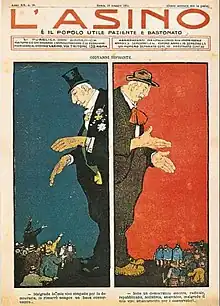| |||||
| Decades: |
| ||||
|---|---|---|---|---|---|
| See also: | |||||
Events from the year 1904 in Italy.
Kingdom of Italy
- Monarch – Victor Emmanuel III (1900–1946)
- Prime Minister – Giovanni Giolitti (1903–1905)
- Population – 33,237,000
Events

This cartoon in the satirical magazine L'Asino (The Donkey) in May 1911, described the policy of Giolitti: on the one hand, dressed in elegant suit, he reassures conservatives; on the other, with clothes less elegant, he is addressing the workers. (L'Asino, May 14, 1911)
The Giolittian Era. During his second and third tenure as Prime Minister (1903–1905 and 1906–1909), Giovanni Giolitti courts the left and labour unions with social legislation, including subsidies for low-income housing, preferential government contracts for worker cooperatives, and old age and disability pensions. Economic expansion was secured by monetary stability, moderate protectionism and government support of production. Foreign trade doubled between 1900 and 1910, wages rose, and the general standard of living went up.[1] Nevertheless, the period was also marked by a sharp increase in the frequency and duration of industrial action, with major labour strikes.
February
- February 17 – The opera Madama Butterfly by Giacomo Puccini, premieres at La Scala in Milan. It was withdrawn after a disastrous premiere and Puccini substantially rewrote it.[2][3]
April
- April 24 – Official visit of French President Émile Loubet to Rome.
July
- July 4 – Piero Ginori Conti tests the first-ever geothermal power generator at the Larderello dry steam field in Italy.[4] It was a small generator that lit four light bulbs.[5]
September
- Series of strikes, including a general strike in September. Prime Minister Giovanni Giolitti refuses to intervene and this attitude prevents the movement to take revolutionary dimensions. Pope Pius X gives tacit permission to Catholic candidates to stand in parliamentary to counter the red menace.[6]
- September 27 – Prime Minister Giovanni Giolitti visits the German Chancellor Bernhard von Bülow to allay concerns in Berlin by the French-Italian rapprochement in relation with the Triple Alliance.
November
- November 6 – First round of the Italian general election.[7]
- November 13 – Second round of the Italian general election. The "ministerial" left-wing bloc of the Historical Left led by Giovanni Giolitti remains the largest in Parliament, winning 339 of the 508 seats.[8] The papal ban on Catholics voting was relaxed for the first time, and three Catholics were elected.[9]
Births
- February 3 – Luigi Dallapiccola, Italian composer (d. 1975)[10]
- April 18 – Giuseppe Terragni, Italian Rationalist architect (d. 1943)[11]
- August 28 – Secondo Campini, Italian jet pioneer (d. 1980)
- November 25 – Toni Ortelli, Italian composer and alpinist (d. 2000)
Deaths
- Emilio Comba, Waldensian pastor and historian (b. 1839)
- February 12 – Antonio Labriola, Italian Marxist theoretician (b. 1843)
References
- ↑ Life World Library: Italy, by Herbert Kubly and the Editors of LIFE, 1961, p. 46
- ↑ "Madame Butterfly Gets Cool Reception – First Production of Puccini's Opera Given at Milan". Los Angeles Herald. Vol. XXXI, no. 142. 18 February 1904. p. 3, col. 1. Retrieved 12 January 2022 – via California Digital Newspaper Collection.
- ↑ Jenkins, Chadwick. "The Fiasco of Madama Butterfly's First Performance: Feb 17, 1904". New York City Opera Project: Madama Butterfly. Columbia University. Retrieved 25 December 2021.
- ↑ Luhr, J.F. (2003). Earth. Dorling Kindersley. p. 205. ISBN 1-4053-0018-3.
- ↑ Tiwari, G.N.; Ghosal, M.K. (2005). Renewable Energy Resources: Basic Principles and Applications. Alpha Science International Ltd. ISBN 1-84265-125-0.
- ↑ Clark, Modern Italy: 1871 to the present, p. 176
- ↑ "Italian Conservatives Gain; Power of Extreme Parties Diminished by Elections Yesterday" (PDF). The New York Times. November 7, 1904.
- ↑ Nohlen, D; Stöver, P (2010). Elections in Europe: A data handbook. p. 1083.
- ↑ Nohlen & Stöver, p. 1031
- ↑ "Luigi Dallapiccola (biography, works, resources)" (in French and English). IRCAM.
- ↑ Notice de personne "Terragni, Giuseppe (1904-1943)" [Person notice "Terragni, Giuseppe (1904-1943)"] (in French). Bibliothèque nationale de France. 5 September 2013. Retrieved 18 February 2022.
- Clark, Martin (2008). Modern Italy: 1871 to the present, Harlow: Pearson Education, ISBN 1-4058-2352-6
This article is issued from Wikipedia. The text is licensed under Creative Commons - Attribution - Sharealike. Additional terms may apply for the media files.
_crowned.svg.png.webp)